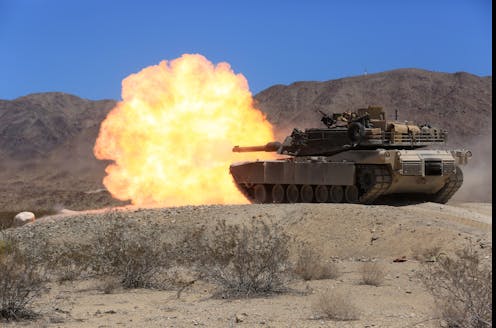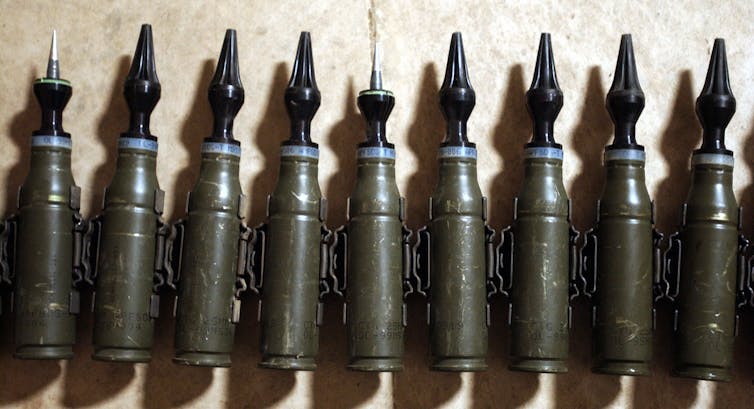The US will send depleted uranium munitions to Ukraine – a health physicist explains their military,
Depleted uranium munitions are bad news for enemy tanks, but are not nuclear weapons, and studies have shown that they pose low risks of radiation or chemical exposure.

The Biden administration has agreed to provide Ukraine with depleted uranium shells to equip M1A1 Abrams tanks that the U.S. is sending there. Britain has already delivered tanks to Ukraine equipped with depleted-uranium shells.
DU munitions, developed in the 1970s, are not nuclear weapons and do not produce a nuclear explosion. But soldiers or civilians can be exposed to the uranium, either in combat or afterward. Health physicist Kathryn Higley explains what depleted uranium is and what’s known about potential health and environmental risks.
What is depleted uranium?
Uranium, symbolized by the letter U, is a naturally occurring element that is radioactive. Natural uranium is composed primarily of three isotopes: U-234, U-235 and U-238.
These isotopes are all uranium and have the same chemical characteristics, but they have slightly different masses, as indicated by the numbers 234, 235 and 238. Depleted uranium is mainly U-238, with small amounts of other isotopes, including U-235.
The isotope U-235 is fissile, which means that it can be split in a reaction that releases a lot of energy. U-235 in fairly low concentrations is used as fuel in commercial nuclear reactors; in high concentrations, it can power nuclear weapons.
Engineers use a process called enrichment to extract U-235 from natural uranium ore. What’s left over after this process removes some of the U-235 is called depleted uranium.
All uranium is radioactive, and each isotope has its own unique half-life. U-238, the most abundant naturally occurring isotope, constitutes about 99.27% of all natural uranium. It takes approximately 4.5 billion years – roughly the life of the Earth – for half of a given quantity of uranium-238 to decay into other elements. U-235 has a half life of about 700 million years and represents about 0.72% of natural uranium.
Depleted uranium is about 40% less radioactive than natural uranium. All isotopes of uranium decay over time, emitting both radiation and energetic particles and transforming into different chemical elements. In this process, they produce specific isotopes of other radioactive elements such as thorium, protactinium and radium.
Why is depleted uranium used in munitions?
Depleted uranium can be manufactured into a very dense material – about 1.7 times more dense than lead. This gives it some desirable characteristics in munitions.
Because DU is a byproduct of the nuclear fuel cycle, plenty of it is readily available. Formed into a projectile, such as a bullet or shell, its high density helps the munition penetrate into a target. Advanced tanks use DU in their armor to protect against armor-piercing munitions.
DU’s density also gives the munition a higher momentum, which enables it to push through materials. Once the munition penetrates a target, it may fragment into smaller pieces and ignite, causing further damage.
Where have depleted uranium munitions been used?
Depleted uranium munitions have been used in the Gulf War in 1990-1991, the Kosovo conflict in the Balkans in 1998-1999 and in U.S. operations in Iraq and Afghanistan. In addition to the U.S. and the U.K., Russia, France and China are known to have DU munitions in their arsenals, and other countries may be importing them.
DU also has nonmilitary applications. Its high density makes it useful for stopping radiation in medical, research and nuclear facilities. It can also be used as ballast to balance weight and provide stability in ships and aircraft.
The alpha radiation that DU emits is not strong enough to penetrate human skin, so just being near depleted uranium is not a health risk. But it may become a health hazard if it is ingested or inhaled, or shrapnel fragments are retained in the body.

Will these munitions create health or environmental risks on Ukrainian soil?
Numerous studies have investigated the potential health effects of exposure to depleted uranium. They include health studies of soldiers hit by DU shrapnel, and biomonitoring – collecting samples of urine, feces, fingernail clippings and hair from exposed individuals. Investigations have included reviews of military personnel exposed during and after combat.
Some studies have observed uranium above natural concentrations in samples collected from soldiers serving in the Gulf War, Bosnia and Afghanistan who had embedded DU fragments in their bodies. In other instances, researchers studying Gulf War Illness in veterans did not find a difference in uranium concentrations in urine between exposed and unexposed groups.
The U.S. Department of Defense and Veterans Administration started monitoring service members for DU exposure during the Gulf War, and this program is still running. So far, the agencies have not observed adverse clinical effects related to documented exposures.
Fragments and much smaller particles from exploded DU munitions can remain in soil long after conflicts end. This has raised concerns about possible radiation or toxic threats to people who come across these materials, such as local residents or peacekeeping forces. In general, studies of people who were inadvertently exposed to battlefield remnants of depleted uranium munitions show low radiation doses and low levels of chemical exposure that were generally indistinguishable from background level.
In terms of environmental impacts, the scientific literature is largely silent on the extent to which plants or animals can absorb DU from munition fragments, although laboratory studies indicate that this is possible. Researchers and health professionals agree that very high levels of uranium, depleted or otherwise, may cause chemical toxicity in plants – but if this were to happen, it would likely be in the immediate vicinity where the munitions exploded. Scientists continue to examine how DU particles behave in the environment, in order to improve our ability to predict long-term environmental effects.
It’s already clear that large areas of Ukraine’s territory will contain the residues of conflict, including weapon fragments, spilled fuels and explosive residues, long after the fighting there ends. The U.S. and U.K. governments clearly believe that providing DU munitions will improve Ukraine’s ability to defeat Russian tanks and bring this conflict to an end.
Kathryn Higley receives / has received funding from U.S. Department of Energy, U.S. Nuclear Regulatory Commission, the International Atomic Energy Agency, Pacific Northwest National Laboratory, and Vanderbilt University. She is affiliated with the National Council on Radiation Protection and Measurements, the International Commission on Radiological Protection, the International Atomic Energy Agency, and the Nuclear Energy Agency.
Read These Next
From truce in the trenches to cocktails at the consulate: How Christmas diplomacy seeks to exploit s
World leaders like to talk up peace at Christmastime. But alongside the tales of seasonal breaks in…
As DOJ begins to release Epstein files, his many victims deserve more attention than the powerful me
Powerful men connected to Jeffrey Epstein are named, dissected and speculated about. The survivors,…
The world risks forgetting one of humanity’s greatest triumphs as polio nears global eradication − 7
Polio may finally be defeated in the next 5 years. Will the world recognize what an extraordinary achievement…






